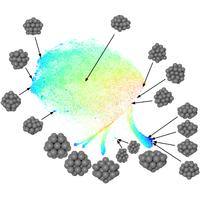Abstract
Energy landscapes provide a conceptual framework for structure prediction, and a detailed understanding of their topological features is necessary to develop efficient methods for their exploration. The ability to visualize these surfaces is essential, but the high dimensionality of the corresponding configuration spaces makes this visualization difficult. Here, we present stochastic hyperspace embedding and projection (SHEAP), a method for energy landscape visualization inspired by state-of-the-art algorithms for dimensionality reduction through manifold learning, such as -SNE and UMAP. The performance of SHEAP is demonstrated through its application to the energy landscapes of Lennard-Jones clusters, solid-state carbon, and the quaternary system . It produces meaningful and interpretable low-dimensional representations of these landscapes, reproducing well-known topological features such as funnels and providing fresh insight into their layouts. In particular, an intrinsic low dimensionality in the distribution of local minima across configuration space is revealed.
8 More- Received 5 May 2020
- Revised 6 August 2021
- Accepted 27 August 2021
DOI:https://doi.org/10.1103/PhysRevX.11.041026
Published by the American Physical Society under the terms of the Creative Commons Attribution 4.0 International license. Further distribution of this work must maintain attribution to the author(s) and the published article’s title, journal citation, and DOI.
Published by the American Physical Society
Physics Subject Headings (PhySH)
Popular Summary
Computational structure prediction—the inference of atomic arrangements—has emerged as a highly successful approach to the discovery of new materials. Candidate structures are created by constructing the most stable configurations that can be adopted by a given set of atomic building blocks. This corresponds to finding the deepest regions of an energy landscape, which is defined by the variation of a system’s energy with the relative positions of its atoms. Efficient methods for exploring these landscapes require a deep understanding of their topologies. However, these surfaces live in spaces with very large numbers of dimensions, making them difficult to visualize. Here, we introduce an approach to visualizing the distribution of stable structures across a high-dimensional energy landscape, based on machine-learning algorithms for dimensionality reduction.
We apply our approach to well-studied model systems and to datasets of realistic solid-state structures (namely, configurations of carbon and the multicomponent system ). Our results reveal known features of these energy landscapes as well as previously undiscovered ones. A key finding is that the distribution of stable structures through the energy landscape can be low dimensional even though the entire surface is not.
Our results demonstrate the power of our approach to visualizing energy landscapes and provide insight that can be used to develop more efficient approaches to structure prediction.



